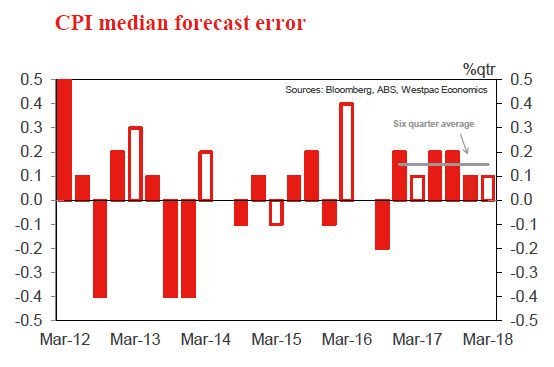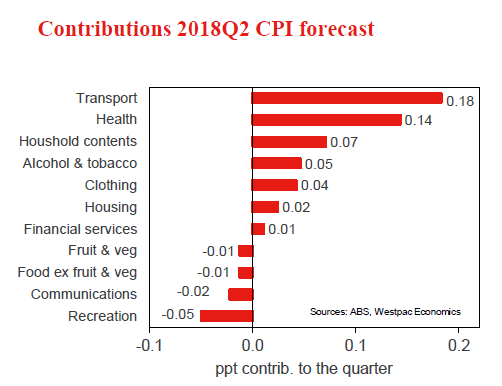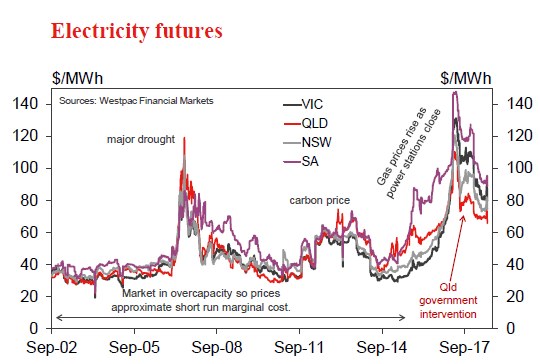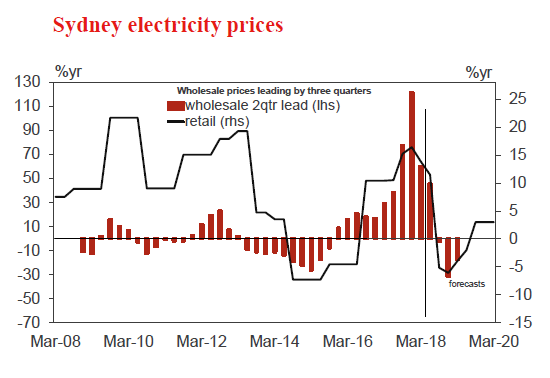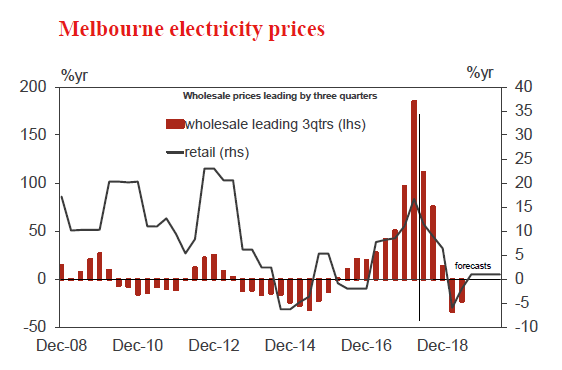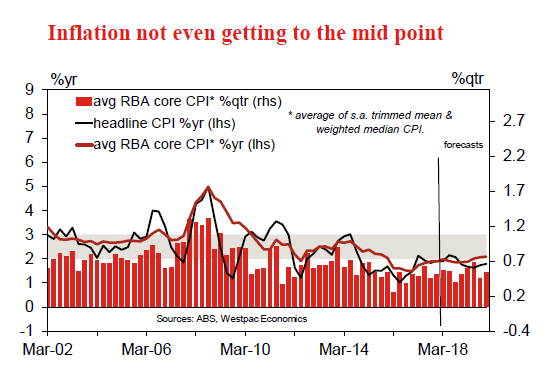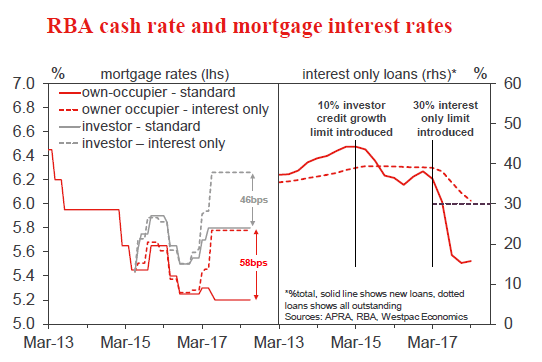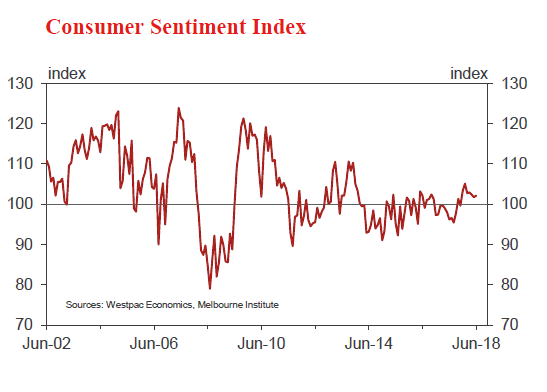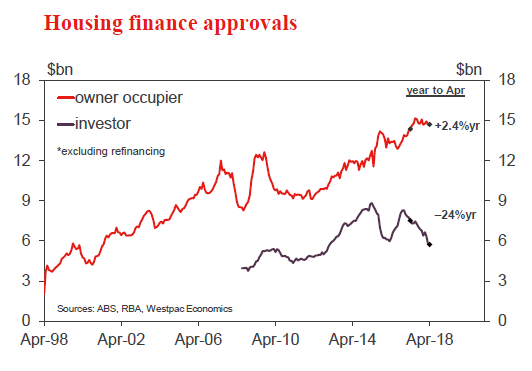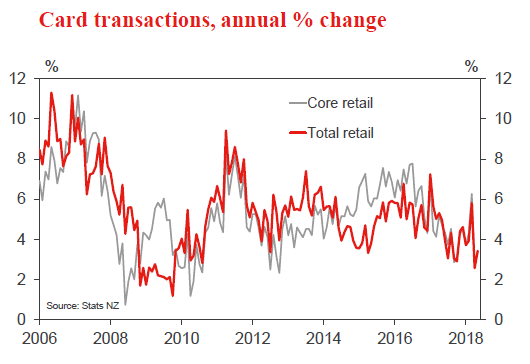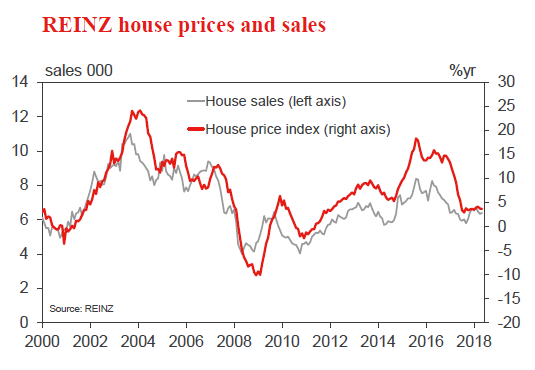Week beginning 9 July 2018
- Falling power bills & moderating housing costs are holding back inflation.
- Australia: Westpac-MI consumer sentiment, housing finance, NAB business survey.
- NZ: retail card spending, REINZ house prices.
- China: CPI, trade balance, credit data.
- Europe: Sentix investor confidence.
- US: CPI, Monetary Policy Report to Congress.
- Central Banks: BOE Governor Carney speaks, BoC, BoK and BNM policy decisions.
- Key economic & financial forecasts.
Information contained in this report current as at 6 July 2018.
Falling Power Bills & Moderating Housing Costs are Holding Back Inflation
With the ABS to publish Q2 CPI on July 25 we turn our focus to inflation trends in Australia and what to expect in the Q2 update.
We noted in the Q1 CPI review searching for Australian inflation continues to be as fruitless as Vladimir and Estragon’s wait for Godot. The Q1 2018 CPI printed 0.4%qtr holding the annual rate flat at 1.9%yr a small moderation from the 2.1%yr pace in 2017 Q1. The average of the core measures rose 0.5%qtr for an annual pace of 2.0%yr a slight uptick from 1.9%yr in Q4/Q3 2017 and 1.8%yr in Q2.
We have now seen six consecutive quarters where forecasters have over-estimated the CPI print. The average error since the December quarter 2016 is +0.15ppt. As a group, market forecasters have been overestimating the inflationary impulse in the Australian economy. We also noted the outright deflation being experienced in the retail sectors with prices falling in the year for clothing (–5.5%yr), footwear (–3.1%yrs), textiles (–2.7%yr), appliances (–2.5%yr), furniture (–1.9%yr) and nondurables (–1.4%yr).
The average error on core inflation over the same period of time is just 0.025ppt so the error appears to be around missing some of the more extreme discounting in certain expenditure classes rather than a general over estimation of the underlying price momentum. We would expect that, just like ourselves, most forecasters are incorporating an ongoing margin squeeze for clothing, footwear and broader household goods. As such, we would be surprised to see a market median forecast significantly higher than our own. Of more concern, however, would be a low median estimate (on par or less than ours) that is still meaningful higher than the final ABS print as this would suggest that the deflationary pulse is deepening.
For the June quarter there are some solid ‘knowns’ but, as always, many ‘unknowns’
For the June quarter, the most obvious standout is the jump in the pump price for petrol and the ongoing price gains in the health sector. Our market data points to fruit & vegetable prices falling in the quarter (with a fall in fruit outweighing a small rise in vegetable prices) while prices for tobacco continue to climb. We also get a guide from BITRE data on domestic travel that suggests the seasonal discounting for domestic travel in the June quarter might not be as great as it has been.
However, outside the above, a large number of unknowns remain. We don’t have data that is comparable to CPI dwelling prices and rents so these components remain educated guesses. We also don’t have access to a lot of the data the ABS uses and, in many cases, it is not possible to replicate the ABS survey process causing many small errors along the way. We use many alternative sources and surveys as a guide but our forecasts are, in the end, based on significant subjective judgement.
June is a seasonally soft quarter
Westpac’s forecast for the June quarter headline CPI is 0.4%qtr with base effects lifting the annual pace to 2.1%yr from 1.9%yr. Westpac’s forecast takes the two quarter annualised pace to 2.1%yr from 1.9%yr in Q1.
June quarter is a seasonally soft quarter with the ABS projecting a seasonal factor of –0.23ppt. However, this exceeds the June quarter seasonal factor for the past two years (average –0.18) so a downward revision to this estimate would not surprise.
Core inflation is forecast to print 0.5%qtr (0.50% at two decimal places) seeing the annual pace ease to 1.9%yr from 2.0%yr. The trimmed mean is forecast to rise 0.52% while the weighted median forecast is 0.49%. The two quarter annualised pace lifts modestly to 2.1%yr from 2.0%yr – at the bottom of the RBA’s target band.
Falling wholesale electricity prices has led to a downward revision to our forecasts
Through 2017, the big story for housing costs was the rise in energy bills, particularly for electricity but also gas. There are timing issues with how electricity bills are repriced in the different capital cities and in the June quarter we are expecting a small seasonal negative driven by falling prices in SA (as demand falls but renewable power remains robust).
However, the more significant change has been the ongoing fall in wholesale prices as renewable generation expansion exceeds expectations and power storage facilities enter commercial application. Some discounting of power bills has been reported and we are expecting this to continue through the remainder of 2018. For Sydney we are looking at electricity prices falling by around 6%yr by end 2018 while in Melbourne the same fall will be experienced in early 2019. For Brisbane electricity price will be falling around 7%yr in the second half of 2018 while in Adelaide we are expecting electricity price to be down –4%yr by end 2018.
The estimates above are all preliminary estimates and a lot will depend on the direction of wholesale electricity prices from here. Wholesale prices have been broadly flat so far in 2018 which is why we are not looking for even larger declines in power bills. However, as at July start, wholesale electricity prices took a dip lower which if it continues, or is even extended, will place further downwards pressure on our forecasts.
Falling power bills are also a key reason for our downgrade to our medium term inflation profile, for both headline and core, out to the end of 2019. We have downgraded our Q2 forecast, it was 0.6%qtr. The fall in wholesale electricity prices has been greater, and longer, than we originally anticipated forcing us to downwardly revise our utilities inflation forecasts. CPI headline inflation is now forecast to peak at 2.1%yr in September 2018 rather than 2.5%yr. End 2019 is now 1.8%yr vs 1.9%yr.
Core measures to remain benign even out to end 2019
Traded prices are forecast to rise 0.7% in the quarter to be up 0.6%yr, while non-traded prices are forecast to rise just 0.2%qtr/2.9%yr as housing costs moderate.
Core inflation remains below the bottom of the RBA target band with household energy bills moderating, and dwelling purchases prices easing through 2018. Overlay a competitive deflationary cycle in consumer goods and it makes it hard to see core inflation breaking much higher. Looking further out, core inflation is forecast to end 2018 at 1.9%yr, while by end 2019, a modest lift to 2.1%yr.
Will market forecasters over estimate the CPI again for a seventh consecutive quarter? Westpac has applied a downward bias to our estimates so it will be interesting to see who else has (or has not) done so and by how much if they have.
Core measures to remain benign even out to end 2019
Traded prices are forecast to rise 0.7% in the quarter to be up 0.6%yr, while non-traded prices are forecast to rise just 0.2%qtr/2.9%yr as housing costs moderate.
Core inflation remains below the bottom of the RBA target band with household energy bills moderating, and dwelling purchases prices easing through 2018. Overlay a competitive deflationary cycle in consumer goods and it makes it hard to see core inflation breaking much higher. Looking further out, core inflation is forecast to end 2018 at 1.9%yr, while by end 2019, a modest lift to 2.1%yr.
Will market forecasters over estimate the CPI again for a seventh consecutive quarter? Westpac has applied a downward bias to our estimates so it will be interesting to see who else has (or has not) done so and by how much if they have.
The week that was
In contrast to the last few, this week had a strong focus on Australia. The RBA met, and we received updates on retail sales; house prices; and dwelling approvals.
Beginning with the RBA, the decision statement of the July meeting carried an unchanged core expectation of above-trend growth in 2018 and 2019 and a consequent gradual firming of wage and inflation pressures. However, a number of nuanced changes to the statement give credence instead to our own view that growth will disappoint and remain sub-trend.
Regarding the global economy, growing trade tensions and instability in the emerging world’s financial markets led to less confidence in the global economy, the RBA statement’s focus shifting from momentum having “strengthened over the past year” to merely “continuing”. On the abnormally high short-term interest rates that Australia has been experiencing, there was (rightful) recognition that this is not solely due to developments in the US, with “other factors at work as well”. What these other factors are continues to be debated by market participants, but it seems likely that much weaker growth in deposits than credit is playing a part.
The consequences of weak deposit growth, also evinced by the historically low household savings rate, range far beyond market rates however. Suffice to say, consumers in a tight financial position are highly unlikely to accelerate their spending; as a result, businesses in related sectors also have little reason to upgrade their investment plans.
Supporting this view, May retail sales underwhelmed this week. At 0.4%, the headline monthly gain beat expectations; but excluding a bounce in clothing and department stores, sales were actually flat in the month. Going forward, a further headwind for consumption growth is likely to develop as declining wealth is increasingly recognised by households.
Key to the wealth narrative, CoreLogic price data indicates June was the ninth consecutive monthly price decline. The correction remains shallow and heavily concentrated in the cities that previously saw the greatest gains (Sydney and Melbourne). But the auction clearance detail suggests this downtrend will continue in coming months. This persistent weakness in prices and tighter financing conditions will also weigh materially on dwelling approvals and thus residential investment through to (at least) the end of 2019.
Turning overseas, China’s PMIs again showed that current momentum in our largest trading partner remains robust. However, two negative trends bear close monitoring. These are abating external demand and continued disappointing employment growth. The deterioration to date is largely as we anticipated and is thus consistent with our sub-consensus view for GDP growth (6.3% and 6.1% in 2018 and 2019). But a further loss of momentum is a risk, particularly given authorities remain focused on the long-term ‘quality’ of growth and are therefore unlikely to spur current momentum with active policy easing as they have in the past.
Across the rest of Asia, PMI data for June indicated that the growth pulse in developed nations such as Japan and South Korea is finding a base after softening in prior months. Emerging Asia is also weathering financial instability well, though there are growing growth risks for nations like Indonesia where policy makers have been forced to react to weakening currencies with sharp interest rate hikes.
Finally to the FOMC minutes from the June meeting. Here we saw the Committee remain committed to their positive view of growth and inflation as well as the consequent need to continue gradually raising the fed funds rate. That said, downside risks emanating from trade frictions and Europe were brought into sharper focus by the Committee, particularly for business investment. Liaison reports from across the US have given the FOMC cause to be vigilant, but it is too early to tell to what degree growth could be affected.
For those in search of some weekend reading, our July Market Outlook has just been released. This edition delves into the growing uncertainty evident in the global growth narrative, both in aggregate and country by country for Australia; the US; Europe and China. For Australia, the evolving structure of our labour market is assessed by state; industry and gender. And from the HILDA survey, there is also a timely profiling of Australia’s interest only borrowers.
Chart of the week: Interest only loans
While the Australian economy has been chugging along with modest strength recently, a point of weakness has been around the uncertain outlook for consumers. Within the household sector, there is a segment coming under particular stress – those with ‘interest only’ mortgages.
As lending conditions have tightened recently, mortgage rates on interest only loans have widened considerably, now sitting 46-58bps higher than their standard counterparts.
Some have subsequently rolled on to standard ‘principal and interest’ loans, and others may be considering a similar move once their interest only periods end. In many cases, these borrowers will be facing increased repayments and may encounter difficulties refinancing against a backdrop of tighter lending criteria. This transition therefore represents a potential downside risk factor to the already sluggish Australian household sector. See our monthly Market Outlook for further detail.
New Zealand: week ahead & data wrap
Recent developments continue to highlight the flagging momentum in the New Zealand economy. While that’s in line with our own forecasts, it has been a surprise to financial markets more generally. As a result, we’ve seen the New Zealand dollar losing ground in recent weeks. In addition, financial market pricing for the Official Cash Rate has been pushed out, and has now caught up with our forecasts for an extended pause from the Reserve Bank.
Momentum in the economy has continued to ease
As we’ve been highlighting for some time, conditions in the New Zealand economy have come off the boil. That’s been highlighted most recently in the latest Quarterly Survey of Business Opinion. General business confidence has fallen to its lowest level since 2011. In addition, businesses across a number of sectors have reported a softening in activity recently, with gauges of trading conditions signalling some downside risk to our forecast for 0.7% GDP growth in the June quarter.
Looking to the back half of the year, businesses remain downbeat about their own prospects and conditions in the economy more broadly. This has seen them scaling back plans for capital expenditure, consistent with our expectations for a lull in investment activity this year.
The past week also saw a sharp 5% drop in dairy prices, effectively taking them to the lower bounds of what we were expecting to see over the course of this season. Prices can be volatile in the fortnightly auctions, and the size of this latest fall was a surprise. Consequently, we’re treating this result with a degree of caution. Nevertheless, we have been warning of the prospect of weaker dairy prices on the back of slowing growth in China for some time. That’s been the key reason our own payout forecast of $6.40 has been sitting below Fonterra’s $7 estimate for the 2018/19 season.
While the wind is coming out of the economy’s sails, that’s not to say that the New Zealand economy is weak. As we’ve been highlighting for some time, the mixed nature of economic developments in recent months reflects that the economy has now moved into a more ‘mature’ phase of the economic cycle. In the wake of the financial crisis, the combination of lingering spare capacity and accelerating population growth provided ample capacity for expansion, with low interest rates helping to stoke demand. However, New Zealand is now into its eighth year of continued expansion, and the economy is encountering some growing pains. Those include difficulties sourcing staff and rising wage costs as the labour market has tightened. At the same time, some of the key drivers of recent economic growth, including rising house prices and construction activity, have moved into new phases, and are no longer providing the same boost to demand that they once did. Balanced against those headwinds, however, demand is continuing to be supported by strength in export earnings (including tourism). And looking ahead, increases in fiscal spending will also provide a significant boost over the coming years.
This changing mix of economic conditions has seen the pace of GDP growth taking a step down. Nevertheless, we still expect the economy will continue growing at a respectable pace over the coming years, with annual GDP growth expected to average a little below 3% through 2019/20.
Changing financial conditions
While the slowdown in the economy has been in line with our expectations, it has come as a surprise to financial markets more generally. As a result, we’ve seen the NZ dollar losing some altitude over the past few weeks, and at the time of writing it was trading a little below US$0.68. We expect that it will fall further over the coming year, as interest rates offshore push higher and the RBNZ stays pat for some time yet.
Interest rates have also fallen, and financial market pricing is now broadly consistent with our long held expectation that the RBNZ will keep the Official Cash Rate on hold until the final quarter of 2019.
There have even been some suggestions that the RBNZ might look at cutting the OCR again over the coming year. However, we don’t think that conditions in the economy warrant a further cut at this stage. Rather than weakness in economic activity, part of the reason that growth has slowed is that spare capacity has been eroded. Even so, GDP is still expanding at a moderate pace, and a substantial increase in fiscal stimulus is planned over the coming years. The drop in the NZ dollar is also helping to buffer the economy, boosting export returns and cushioning the effects of slowing activity in other sectors
The inflation backdrop also looks quite different from when the RBNZ last cut rates. Over the past decade, consumer price inflation often struggled to reach even 1%. However, inflation has now picked up again, and in this week’s QSBO businesses reported a large increase in input costs. Some of this is no doubt related to the rise in petrol prices. More generally, businesses are reporting stretched capacity. They are also reporting increases in wage costs as the labour market has tightened and minimum wage rate has risen.
This increase in cost pressures is consistent with our forecast for a near-term rise in consumer prices, with CPI inflation expected to briefly reach the 2% mid-point of the RBNZ’s target band later this year. With much of this increase related to a rise in oil prices, we do expect that inflation will ease back again next year. Nevertheless, inflation is still expected to remain well within the RBNZ’s target band.
Data Previews
Aus Jul Westpac-MI Consumer Sentiment
- Jul 11 Last: 102.1
The consumer mood improved marginally in 2018, the first half of the year marking the best run of sentiment reads since 2014. That said, the Index has not built on the gains seen at the start of the year and remains well below the levels typically associated with a robust consumer. While there has been a clear lift in confidence around the economy, this has had a muted impact on views around family finances, which remain downbeat.
The July survey is in the field from July 2-7. Factors that may influence this month include: the RBA’s decision to leave official rates on hold, recent comments emphasising that any move is still a long way off; the passage of the Federal government’s tax cuts into legislation and a proposed reconfiguration of GST allocations that sees ‘no state worse off’; continued slippage in dwelling prices, now down 1.6%yr. Financial markets have had a mixed, the ASX up 2.8% but the AUD down 2.3c vs the USD. Offshore, global trade tensions have again been to the fore.
Aus May housing finance (no.)
- Jun 11, Last: –1.4%, WBC f/c: –2.0%
- Mkt f/c: -2.0%, Range: -2.5% to -0.2%
After holding relatively steady through most of 2017 and early 2018, Australian housing finance approvals showed a notable pull back in recent months. The total number of owner occupier approvals declined a further 1.4% in April with the value of investor loans down 0.9%. Conditions were soft across most of the detail. Combined, the total value of approvals ex refi fell 0.4%mth to be down 5.8%yr.
Industry figures point to a further decline in owner occupier approvals in May – we expect the official figures to show a 2.0% drop. Auction data showed a clear further weakening in the Sydney and Melbourne markets through May and early June. Some of this likely reflects tightening lending standards which may have had multiple effects including longer processing times for loan approvals, a higher decline rate for loan applications and reduced assessments of borrowing capacity. The May finance approvals should help confirm some of these aspects.
NZ Jun retail card spending
- Jul 10 Last +0.4%, WBC f/c: +0.4%
After a large 2.2% fall in April, retail spending only rose by a modest 0.4% in May. Smoothing through the month-tomonth volatility, it looks like after a solid start to the year, the momentum in retail spending has faded. In fact, except for a holiday related rise in March, retail spending has essentially been flat since January.
Much of the softness in household spending is likely to stem from policy changes aimed at cooling the housing market. We expect house price inflation will remain muted through mid-2018.
We expect that spending growth will remain weak in June and are forecasting a 0.4% gain. That will leave us with a picture of essentially flat spending levels through the first half of the year.
NZ Jun REINZ House Price Index (s.a.)
- Jul 10 (tentative date) Last: -0.2%
After a brief resurgence around the turn of the year, the New Zealand housing market has cooled. Prices are now falling in Auckland, Wellington and Christchurch, and rising slowly elsewhere. Measured nationwide, house prices have been roughly flat.
The Bright Line Test for taxing capital gains was extended to five years in late March, and this is impacting the market at present. The next negative factor for the market will be the foreign buyer ban, set to become law within a month. However, one offsetting positive for the market at present is falling mortgage rates.
June REINZ data is expected to continue the recent trend of slowing sales and flat prices.




